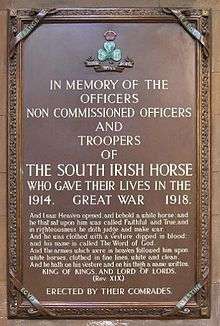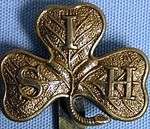South Irish Horse
| South Irish Horse | |
|---|---|
|
Regimental Badge | |
| Active | 1902-1922 |
| Country | United Kingdom of Great Britain and Ireland |
| Branch | Army |
| Type | Yeomanry |
| Role | Cavalry |
| Commanders | |
| Current commander | Defunct |
| Colonel-in-Chief | Field Marshal HRH Arthur W. P. A., Duke of Connaught and Strathearn, KG, KT, KP, GCB, GCSI |
The South Irish Horse was a Special Reserve cavalry regiment of the British Army. Formed on 2 January 1902 as the South of Ireland Imperial Yeomanry. It was renamed as the South Irish Horse from 7 July 1908 and transferred to the Special Reserve (Cavalry). After fighting in the Great War the unit was disbanded in 1922 following the implementation of the Anglo-Irish Treaty.
History



The declaration of war against Germany in August 1914 found the South Irish Horse at summer camp, as was its sister regiment the North Irish Horse. Together they supplied a composite regiment who acted as GHQ (General Headquarters) troops in the BEF (British Expeditionary Force) in France, B Squadron from the South Irish Horse and two from the North Irish Horse.
- Squadrons
HQ - Artillery Barracks, Limerick.
A Squadron - Beggars Bush Barracks, Dublin
B Squadron - Artillery Barracks, Limerick. (known as "S" Squadron on first deployment to France).
C Squadron - Glen House, Ballyvolane, Cork.
D Squadron - Beggars Bush Barracks, Dublin
Briefly, the regiment served as separate divisional cavalry squadrons and then as 2 corps cavalry regiments. In September 1917 the officers and men of both regiments were retrained as infantry and formed 7th (South Irish Horse) Battalion Royal Irish Regiment. The battalion was posted to 49th Infantry Brigade in 16th (Irish) Division. A look at the list of war dead will show 21 men recorded as Killed in Action on 12 December 1917 and a further 9 Died of Wounds by the end of the month. All of these men had previously been in the South Irish Horse.
On 21 March 1918 the battalion was caught in the maelstrom of the German Kaiserschlacht (Kaiser's Battle) Spring offensive. The Official History records that, "2 Coys of 7/Royal Irish posted in forward zone suffered terribly; not a man succeeded in escaping." 77 officers and men of 7th (SIH) Royal Irish Regiment were killed in action that day, 42 were formerly South Irish Horse. 14 officers of the battalion were captured that day 6 of whom were formerly South Irish Horse. By the end of the month over 90 men of the battalion were dead or dying. According to the War Diary of 49th Infantry Brigade the battalion strength on 30 March 1918 was 1 officer and 34 other ranks. The battalion strength on 20 March is not known but a sister battalion (2nd Royal Irish Regiment) in the brigade had a strength of 18 officers and 514 men before the battle and 1 officer and 31 other ranks on 30 March. 15 officers of this battalion were also captured (two of whom were also formerly South Irish Horse).
The regiment was one of the six British Army regiments disbanded in 1922 as a result of the Partition of Ireland, having only existed for a mere 20 years.[1]
Battle honours
Loos - Somme, 1916, 1918 - Albert, 1916 - St Quentin - Rosières - Avre - Ypres, 1918 - Courtrai - France and Flanders, 1915-18.
Association
The regiment no longer has an association but dependents may still get assistance from the Army Benevolent Fund.[2]
The Combined Irish Regiments Association also remains as a source of information and for those who wish to remember the disbanded regiments.[3]
Great War Memorials
- Irish National War Memorial Gardens, Dublin.
- Island of Ireland Peace Park Messines, Belgium.
- Menin Gate Memorial Ypres, Belgium.
- Ulster Tower Memorial Thiepval, France.
References
- ↑ http://southirishhorse.com/
- ↑ http://www.armybenfund.org/howwehelp/ifyouneedhelp.html
- ↑ "Combined Irish Regiments". Combined Irish Regiments.
External links
- Official website
- ciroca.org.uk
- 1914-1918.net
- yourarchives.nationalarchives.gov.uk
- waterfordcountymuseum.org
- Department of the Taoiseach - Irish Soldiers in the First World War
- irishwarmemorials.ie


